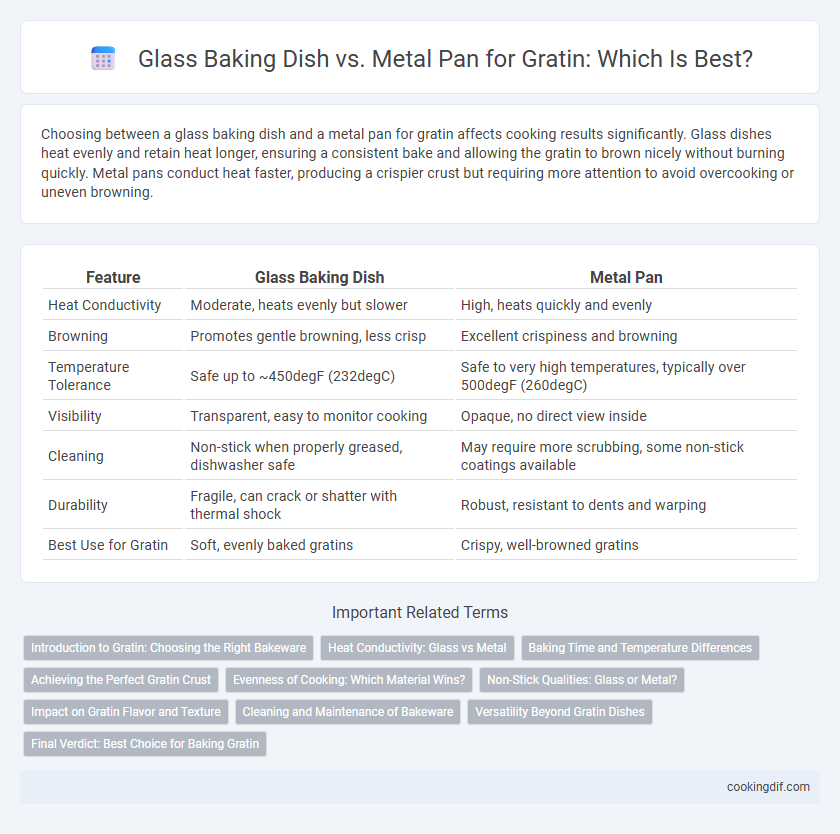Choosing between a glass baking dish and a metal pan for gratin affects cooking results significantly. Glass dishes heat evenly and retain heat longer, ensuring a consistent bake and allowing the gratin to brown nicely without burning quickly. Metal pans conduct heat faster, producing a crispier crust but requiring more attention to avoid overcooking or uneven browning.
Table of Comparison
| Feature | Glass Baking Dish | Metal Pan |
|---|---|---|
| Heat Conductivity | Moderate, heats evenly but slower | High, heats quickly and evenly |
| Browning | Promotes gentle browning, less crisp | Excellent crispiness and browning |
| Temperature Tolerance | Safe up to ~450degF (232degC) | Safe to very high temperatures, typically over 500degF (260degC) |
| Visibility | Transparent, easy to monitor cooking | Opaque, no direct view inside |
| Cleaning | Non-stick when properly greased, dishwasher safe | May require more scrubbing, some non-stick coatings available |
| Durability | Fragile, can crack or shatter with thermal shock | Robust, resistant to dents and warping |
| Best Use for Gratin | Soft, evenly baked gratins | Crispy, well-browned gratins |
Introduction to Gratin: Choosing the Right Bakeware
Glass baking dishes provide even heat distribution and allow for easy monitoring of the gratin's browning, enhancing the visual appeal and ensuring thorough cooking. Metal pans heat faster and create a crispier, golden crust, ideal for achieving the signature gratin texture. Selecting the right bakeware impacts the dish's moisture retention, browning, and overall flavor, making glass and metal options suited to different gratin styles.
Heat Conductivity: Glass vs Metal
Glass baking dishes offer moderate heat conductivity, allowing for slow and even heat distribution that helps gratins cook uniformly without burning. Metal pans, particularly aluminum or stainless steel, conduct heat more quickly and intensely, resulting in faster cooking and a crispier, more browned crust on gratins. Choosing between glass and metal depends on desired texture, with glass favoring even cooking and metal enhancing browning through superior heat conduction.
Baking Time and Temperature Differences
Glass baking dishes retain heat longer and distribute it more evenly, resulting in slightly longer baking times and typically lower oven temperatures than metal pans to prevent overcooking. Metal pans heat up quickly and promote crispier edges, often requiring higher temperatures and shorter baking times for gratin dishes. Adjusting baking temperature by 25degF lower for glass compared to metal pans helps achieve optimal browning and texture.
Achieving the Perfect Gratin Crust
Glass baking dishes retain heat evenly, promoting a consistent bake and allowing the gratin to brown gradually, which enhances the crust's depth of flavor. Metal pans, particularly aluminum or stainless steel, conduct heat quickly and promote a crispier, more intensely browned crust due to increased surface temperature. Selecting the right dish influences the gratin's texture, with metal pans favoring a crunchy crust and glass offering a tender, golden-brown finish.
Evenness of Cooking: Which Material Wins?
Glass baking dishes offer superior heat retention, promoting even cooking and consistent browning in gratins, while metal pans heat up faster, often leading to crispier edges but uneven interior cooking. The thermal conductivity of metal ensures quick heat distribution, but it may cause hot spots, risking overcooked edges and undercooked centers. Glass provides a more uniform cooking environment, making it ideal for dishes requiring gentle, even heat throughout the cooking process.
Non-Stick Qualities: Glass or Metal?
Glass baking dishes offer superior non-stick qualities compared to metal pans, as their smooth, non-porous surface prevents food from adhering and promotes even browning in gratin dishes. Metal pans, especially those without a non-stick coating, tend to stick more and may require additional greasing or parchment paper to prevent food from clinging. For gratin recipes where a delicate crust is desired, glass provides an easier release and cleaner presentation.
Impact on Gratin Flavor and Texture
Glass baking dishes retain heat evenly, promoting a consistent, tender gratin with a creamy interior and a lightly browned crust. Metal pans, especially aluminum or stainless steel, conduct heat more quickly, producing a gratin with a crispier, more caramelized top layer and slightly firmer texture. The choice between glass and metal directly influences the balance between smoothness and crunch in the final gratin.
Cleaning and Maintenance of Bakeware
Glass baking dishes for gratin are non-porous, making them easier to clean and resistant to staining or retaining odors compared to metal pans. Metal pans can develop baked-on residues and may require soaking or scrubbing with abrasives, potentially leading to scratches or discoloration over time. Choosing glass bakeware improves maintenance efficiency and durability, especially for dishes like gratins that involve creamy, browned toppings.
Versatility Beyond Gratin Dishes
Glass baking dishes offer excellent heat retention and even cooking, making them ideal for dishes like gratins that benefit from slow, steady baking. Metal pans excel at conducting heat quickly, resulting in crispier edges and faster cooking times, suitable for roasted vegetables and baked goods. Beyond gratins, glass dishes double as attractive servingware, while metal pans provide versatile options for broiling, frying, and high-temperature baking.
Final Verdict: Best Choice for Baking Gratin
Glass baking dishes provide even heat distribution that enhances the golden-brown crust essential for a perfect gratin, while metal pans offer superior heat conduction for faster cooking times and crispier edges. For a balanced gratin with a tender interior and well-browned top, glass dishes are favored by many chefs, especially when baking at moderate temperatures. The best choice depends on whether you prioritize a gentle, thorough bake or quicker, more intense crisping around the edges.
Glass baking dish vs metal pan for baking Infographic

 cookingdif.com
cookingdif.com